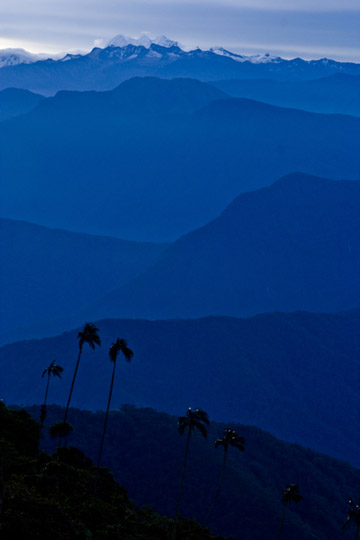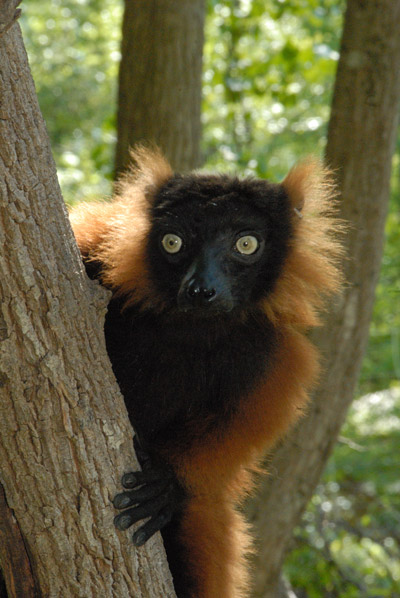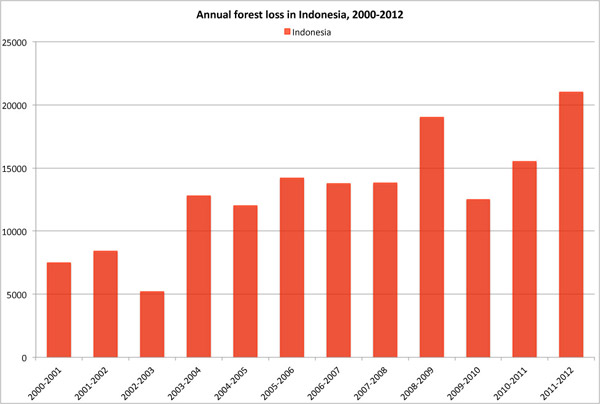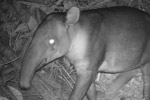Want to save the world’s biodiversity from mass extinction? Then make certain to safeguard the 74 sites identified today in a new study in Science. Evaluating 173,000 terrestrial protected areas, scientists pulled out the most important ones for global biodiversity based on the number of threatened mammals, birds, and amphibians found in the parks. In all they identified 137 protected areas (spread over 74 sites as many protected areas were in the same region) in 34 countries as “irreplaceable.”
“We highlight a set of exceptionally irreplaceable [protected areas] for which we recommend a particularly high level of management effort and encourage global recognition as World Heritage sites,” the authors write.
According to the study, the most important protected area in the world for threatened species is the Sierra Nevada de Santa Marta Natural National Park in Colombia. Safeguarding a distinct mountain range on the Caribbean coastline, the Sierra Nevada de Santa Marta Natural National Park is home to over 40 endemic species, i.e. those found no-where else, including many that are threatened with extinction. The list also includes a number of more well-known parks and sites, including the Galapagos Islands, Manu National Park in the Peruvian Amazon, the Western Ghats in India, and the Leuser ecosystem in Sumatra. Many of the ecosystems in question are tropical islands or mountain rainforests, both of which contain high biodiversity found no-where-else.
 Santa Marta Natural National Park in Colombia is the most irreplaceable protected area in the world according to a new study. Photo by: Robin Moore. |
Indonesia is home to the largest number of site on the list—eight. This is perhaps not surprising given the mega-biodiverse country’s ongoing issues with deforestation. Next is Venezuela with five sites, while Brazil, China, Colombia, Mexico, and Peru have four sites each. The U.S. has one site—that incorporates several parks in the Hawaiian Islands—while the UK has two sites, both of which are on far-flung tropical island territories: Gough and Inaccessible Islands World Heritage Site and Henderson Island in the South Pacific.
Notably, only around half of the sites identified have yet to be given UNESCO World Heritage status, including the most important site, the Sierra Nevada de Santa Maria. Others that have yet to be listed include the Udzungwa Mountains National Park in Tanzania and Ciénaga de Zapata Wetland of International Importance in Cuba.
“These exceptional places would all be strong candidates for World Heritage status,” says Soizic Le Saout, lead author of the study, with the Centre d’Ecologie Fonctionnelle et Evolutive. “Such recognition would ensure effective protection of the unique biodiversity in these areas, given the rigorous standards required for World Heritage sites.”
While the sites listed already fall under protected areas, conservationists say that doesn’t mean they are well protected. Many of the world’s parks and reserves suffer from underfunding, poor management, poaching, deforestation, and industrial projects, such as road-building, hydro power, mining, and fossil fuel extractive.
“Páramo Urrao National Protective Forests Reserves, in Colombia, for example, does not really exist,” says Paul Salaman, an expert in Colombian biodiversity and CEO of the Rainforest Trust. “It was legally created in 1975, but this was never translated into on-the-ground management.”
Protected areas are also increasingly under attack by the very governments that created them. In many countries, protected areas are facing downgrading (a change in legal status), downsizing (a decrease in their borders), and even degazettement (outrigtht abolishment of the park) often in order to accommodate extractive industries such as oil, gas, logging, and mining. This recently identified trend has been dubbed PADDD (or protected areas downgraded, downsized, or degazetted).
“Protected areas can only fulfill their role in reducing biodiversity loss if they are effectively managed,” says co-author Simon Stuart, chair of the IUCN Species Survival Commission. “Given limited conservation budgets, that is not always the case, so governments should pay particular attention to the management effectiveness of highly irreplaceable protected areas.”

78 sites identified by a new study as the most irreplaceable protected areas in the world. Click to enlarge.

Waterfall in Canaima National Park World Heritage Site. The waters are naturally red waters due to dissolved minerals. Photo by: Charles Besancon.

Grey-faced sengi (Rhynchocyon udzungwensis) in Udzungwa Mountains National Park in Tanzania. This species is listed as Vulnerable by the IUCN Red List. Photo by: Francesco Rovero.

The black-chinned laughingthrush (Strophocincla cachinnans) in the Western Ghats in India. Photo by: Kalyan Varma.

Red-ruffed lemur (Varecia rubra). Madagascar is home to three sites on the list. Photo by: R.A. Mittermeier.

Indonesia deforestation rate 2000-2012.
Citations:
- Soizic Le Saout, Michael Hoffmann, Yichuan Shi, Adrian Hughes, Cyril Bernard, Thomas M. Brooks, Bastian Bertzky, Stuart H. M. Butchart, Simon N. Stuart, Tim Badman, Ana S. L. Rodrigues. (2013) Protected Areas and Effective
Biodiversity Conservation. Science. Vol 342.
Related articles
Locally extinct birds in the Amazon slowly flock back to forests when trees regrow

(11/13/2013) Some good news out of the Amazon rainforest: given enough time, deforested land can rebound enough to host bird species that had previously deserted the area, according to a recent study in The Auk. When people abandon deforested land, the rainforest slowly reclaims it. Eventually, birds begin to use the clumps of secondary forest as corridors between thickets of old growth.
Could camera trap videos galvanize the world to protect Yasuni from oil drilling?

(11/07/2013) Even ten years ago it would have been impossible to imagine: clear-as-day footage of a jaguar plodding through the impenetrable Amazon, or a bicolored-spined porcupine balancing on a branch, or a troop of spider monkeys feeding at a clay lick, or a band of little coatis racing one-by-one from the dense foliage. These are things that even researchers who have spent a lifetime in the Amazon may never see. Now anyone can: scientists at the Tiputini Biodiversity Station in Ecuador’s Yasuní National Park have recently begun using camera trap videos to take movies of animals few will ever view in their lifetimes. The videos—following years of photo camera trapping—provide an intimate view of a world increasingly threatened by the oil industry.
(10/30/2013) The Rainforest Trust, which from 1988 until last month was known as the World Land Trust-US, has kicked off an effort to preserve some 2.4 million hectares (5.9 million acres) of rainforest in a remote part of the Peruvian Amazon.
Map reveals gas company flying over Manu National Park

(10/17/2013) A map in an internal Peruvian government report reveals that gas company Pluspetrol has been flying over the protected Manu National Park (MNP) in the south-eastern Peruvian Amazon where UNESCO says the biodiversity “exceeds that of any other place on earth.”
The over-flight was done via helicopter on 3 February, 2012 by Pluspetrol personnel together with a team from the National Institute e Development of Andean, Amazonian and Afroperuvian Peoples (INDEPA).
Tapirs, drug-trafficking, and eco-police: practicing conservation amidst chaos in Nicaragua

(10/10/2013) Nicaragua is a nation still suffering from deep poverty, a free-flowing drug trade, and festering war-wounds after decades of internecine fighting. However, like any country that has been largely defined by its conflicts, Nicaragua possesses surprises that overturn conventional wisdom. Not the least of which is that the Central American country is still home to big, stunning species, including jaguars, giant anteaters, pumas, and the nation’s heaviest animal, the Baird’s tapir (Tapirus bairdii). Still, not surprisingly given the nation’s instability, most conservationists have avoided Nicaragua. But tapir-expert Christopher Jordan, who has worked in the country for over four years, says he wouldn’t have it any other way.
Over 100 scientists warn Ecuadorian Congress against oil development in Yasuni

(10/03/2013) Over 100 scientists have issued a statement to the Ecuadorian Congress warning that proposed oil development and accompanying roads in Yasuni National Park will degrade its “extraordinary biodiversity.” The statement by a group dubbed the Scientists Concerned for Yasuni outlines in detail how the park is not only likely the most biodiverse ecosystems in the western hemisphere, but in the entire world. Despite this, the Ecuadorian government has recently given the go-ahead to plans to drill for oil in Yasuni’s Ishpingo-Tambococha-Tiputini (ITT) blocs, one of most remote areas in the Amazon rainforest.
Wildlife in Nilgiris Biosphere Reserve suffers from lack of a transition zone

(10/01/2013) The Nilgiris Biosphere Reserve in southern India acts as a conduit between the biodiversity-rich Western Ghats, a mountain range parallel to the western coast of India and its eastern counterpart, the Eastern Ghats. Established in 1986 by Government of India, the 5,520 square kilometer reserve was recognized by UNESCO in 2000. However a new study in mongabay.com’s open-access journal Tropical Conservation Science finds that the lack of a transition zone in the Nilgiris Biosphere Reserve has undercut the aims of this crucial protected area.
Has Brazil turned against its progressive environmental policies?

(09/30/2013) Last year, Brazil rolled back crucial parts of its landmark Forestry Code, potentially opening vast tracts of forest for destruction; it is also moving ahead on a number of Amazon dams, including the infamous Belo Monte, despite international condemnation and conflict with indigenous people. Meanwhile, a new law under consideration proposes allowing large-scale mining in protected areas. Given this a new paper in mongabay.com’s open access journal Tropical Conservation Science argues that Brazil has thrown off its once admired mantle of environmental legislation, imperiling hundreds of thousands of species in the most biodiverse country on Earth.
Malaysia clearcutting forest reserves for timber and palm oil

(09/26/2013) In July Bikam Permanent Forest Reserve in Malaysia’s Perak state was degazetted, allowing the forest to be clearcut for an oil palm plantation. Only after the forest was lost, did the Forest Research Institute Malaysia (FRIM) announce that it had contained the last stands of keruing paya (Dipterocarpus coriaceus) on the Malay peninsula, a large hardwood tree that’s classified as Critically Endangered on the IUCN Red List. The species is now reportedly extinct in Malaysia, although may still be found in Indonesia. However, the degazettement of the 400-hectare Bikam Forest Reserve wasn’t an abnormality, according to activists. Since 2009, over 9,000 hectares of Permanent Forest Reserves have been degazetted in northwestern state, wiping out not just trees, but undercutting protected mammals and birds while threatening watersheds.